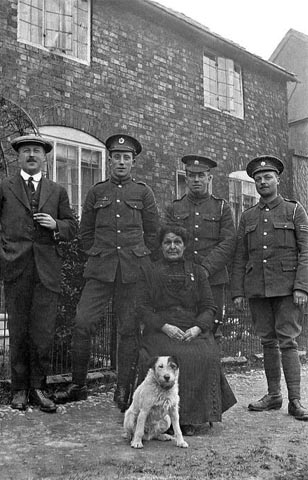A hundred years ago in February 1915, over 200 officers and men, of the 2nd Lowland Field Company, Royal Engineers, arrived in Southam from Scotland. They were part of the newly formed 29th Division destined for service in Gallipoli. Trainloads of officers, men, horses, artillery and other equipment had been arriving in Warwickshire for the previous two months. The Scotsmen were some of the last to arrive.
Where ever the troops arrived, crowds came to see them. As in other towns, troops billeted in households in Southam made an impact. Householders were paid 17s 6d per week for each soldier. To many it replaced an income lost when a family member had joined up. People were willing to take in the men and in some towns there was even a disgruntled note from those not allocated a soldier as a paying ‘guest’. To the Tommies, the homely accommodation was a glorious relief from life under canvas. Rugby people thought of them as ‘our boys’ and kept in touch sending parcels, and mourning, when they heard of losses.

Details of their stay in Southam are scarce. The Lowlanders played Southam at football: result 5:5. A grainy photograph in Southam Heritage Collection shows a musical group of soldiers outside the Bull pub (then called the Dun Cow) playing fiddle, accordion, bagpipes, tin whistle, and two watering cans!
Two recent acquisitions to the Collection fill in a few details. The autograph book of Winnie Tolley shows signatures of Sappers M. MacDermid (2421) and Robert Alan (2545). Perhaps these lads were billeted at Vivian House on Market Hill, where the Tolley family lived. This photograph of Mrs Moyna Gosden wearing her Red Cross badge (she was later to become a VAD) is taken outside her home in Coventry Street with three soldiers thought to be Lowlanders.
The Division set sail between 16-22 March 1915. Before that, they assembled in Dunchurch, some 20,000 men, to parade before King George V. As he reviewed the troops on London Road (now A45), regimental bands, and corps of pipes and drums played. As the Lowlanders marched from Southam to Dunchurch in excited mode, they could have had little inkling of the carnage that awaited them in Gallipoli.
There is a monument at the interchange of the Fosse and the A45, and when next you drive past, spare a thought for the 29th Division. Major General Cayley at the unveiling of the obelisk in 1921 said ‘It was the friendship, the hospitality and the kind welcome you gave us …that helped us to feel … England was worth dying for’.
If you can contribute to our research into WWI Southam, or would like more information about Southam Heritage Collection please telephone Bernard on 01926 613503 or email cardallcollection@hotmail.co.uk

Leave A Comment